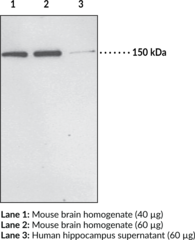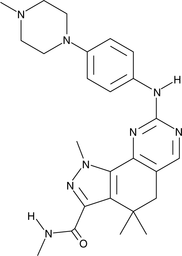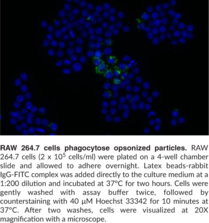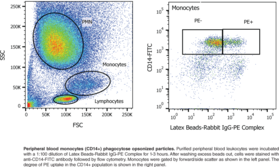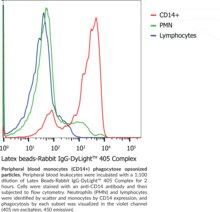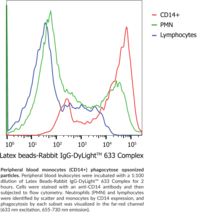Cayman
Showing 34801–34950 of 45550 results
-
PFK158 is an inhibitor of 6-phosphofructo-2-kinase/fructose-2,6-bisphosphatase 3 (PFKFB3; IC50 = 137 nM for human recombinant PFKFB3).{37211} It inhibits PFKFB3 and glycolysis in Jurkat cells (IC50s = 1.6 and 0.847 μM, respectively). PFK158 inhibits the growth of leukemia cells in vitro (IC50 = 0.33 μM for Jurkat cells) and reduces tumor volume in CT-26 murine colon carcinoma syngeneic model and a BxPC-3 pancreatic cancer mouse xenograft model. PFK158 also enhances activity of the anti-CTLA-4 antibody in the B16/F10 mouse model of melanoma.{37212}
Brand:CaymanSKU:22987 - 25 mgAvailable on backorder
PFK158 is an inhibitor of 6-phosphofructo-2-kinase/fructose-2,6-bisphosphatase 3 (PFKFB3; IC50 = 137 nM for human recombinant PFKFB3).{37211} It inhibits PFKFB3 and glycolysis in Jurkat cells (IC50s = 1.6 and 0.847 μM, respectively). PFK158 inhibits the growth of leukemia cells in vitro (IC50 = 0.33 μM for Jurkat cells) and reduces tumor volume in CT-26 murine colon carcinoma syngeneic model and a BxPC-3 pancreatic cancer mouse xenograft model. PFK158 also enhances activity of the anti-CTLA-4 antibody in the B16/F10 mouse model of melanoma.{37212}
Brand:CaymanSKU:22987 - 5 mgAvailable on backorder
PG-01037 is a selective dopamine D3 receptor antagonist (Kis = 0.7, 93, and 375 nM for HEK293 cells expressing human D3, D2, and D4 receptors, respectively).{34174} It inhibits quinpirole-induced stimulation of mitogenesis in CHO cells expressing human dopamine D3 receptors (EC50 = 3 nM). PG-01037 (32 mg/kg) reduces progressive-ratio methamphetamine self-administration in rats allowed extended access.{36955} It reduces loss of dopaminergic neurons in the substantia nigra pars compacta and improves motor performance in the coat-hanger test in a mouse model of Parkinson’s disease induced by MPTP.{36956}
Brand:CaymanSKU:22079 -Out of stock
PG-01037 is a selective dopamine D3 receptor antagonist (Kis = 0.7, 93, and 375 nM for HEK293 cells expressing human D3, D2, and D4 receptors, respectively).{34174} It inhibits quinpirole-induced stimulation of mitogenesis in CHO cells expressing human dopamine D3 receptors (EC50 = 3 nM). PG-01037 (32 mg/kg) reduces progressive-ratio methamphetamine self-administration in rats allowed extended access.{36955} It reduces loss of dopaminergic neurons in the substantia nigra pars compacta and improves motor performance in the coat-hanger test in a mouse model of Parkinson’s disease induced by MPTP.{36956}
Brand:CaymanSKU:22079 -Out of stock
PG-01037 is a selective dopamine D3 receptor antagonist (Kis = 0.7, 93, and 375 nM for HEK293 cells expressing human D3, D2, and D4 receptors, respectively).{34174} It inhibits quinpirole-induced stimulation of mitogenesis in CHO cells expressing human dopamine D3 receptors (EC50 = 3 nM). PG-01037 (32 mg/kg) reduces progressive-ratio methamphetamine self-administration in rats allowed extended access.{36955} It reduces loss of dopaminergic neurons in the substantia nigra pars compacta and improves motor performance in the coat-hanger test in a mouse model of Parkinson’s disease induced by MPTP.{36956}
Brand:CaymanSKU:22079 -Out of stock
PG-01037 is a selective dopamine D3 receptor antagonist (Kis = 0.7, 93, and 375 nM for HEK293 cells expressing human D3, D2, and D4 receptors, respectively).{34174} It inhibits quinpirole-induced stimulation of mitogenesis in CHO cells expressing human dopamine D3 receptors (EC50 = 3 nM). PG-01037 (32 mg/kg) reduces progressive-ratio methamphetamine self-administration in rats allowed extended access.{36955} It reduces loss of dopaminergic neurons in the substantia nigra pars compacta and improves motor performance in the coat-hanger test in a mouse model of Parkinson’s disease induced by MPTP.{36956}
Brand:CaymanSKU:22079 -Out of stock
Prostaglandin D2 (PGD2) plays a pharmacological role in allergic and asthmatic anaphylaxis, normal physiological sleep and lowering of body temperature, as well as inhibits platelet aggregation and relaxes vascular smooth muscle.{580} PGDM is a major urinary metabolite of PGD2 with a unique lower sidechain that readily undergoes reversible cyclization.{35} It is used as a biomarker to assess endogenous production of PGD2.
Brand:CaymanSKU:-Prostaglandin D2 (PGD2) plays a pharmacological role in allergic and asthmatic anaphylaxis, normal physiological sleep and lowering of body temperature, as well as inhibits platelet aggregation and relaxes vascular smooth muscle.{580} PGDM is a major urinary metabolite of PGD2 with a unique lower sidechain that readily undergoes reversible cyclization.{35} It is used as a biomarker to assess endogenous production of PGD2.
Brand:CaymanSKU:-Prostaglandin D2 (PGD2) plays a pharmacological role in allergic and asthmatic anaphylaxis, normal physiological sleep and lowering of body temperature, as well as inhibits platelet aggregation and relaxes vascular smooth muscle.{580} PGDM is a major urinary metabolite of PGD2 with a unique lower sidechain that readily undergoes reversible cyclization.{35} It is used as a biomarker to assess endogenous production of PGD2.
Brand:CaymanSKU:-PGP-4008 is a selective inhibitor of P-glycoprotein (P-gp) that does not affect the activity of multidrug resistance-related protein 1 (MRP1).{32706,32707} It is effective in vitro and, when delivered intraperitoneally, in vivo, inhibiting tumor growth when given with doxorubicin (Item No. 15007).{32706,32707} PGP-4008 also enhances the ability of docetaxel (Item No. 11637) to inhibit growth and drive apoptosis in ovarian cancer cells.{32708}
Brand:CaymanSKU:20901 -Out of stock
PGP-4008 is a selective inhibitor of P-glycoprotein (P-gp) that does not affect the activity of multidrug resistance-related protein 1 (MRP1).{32706,32707} It is effective in vitro and, when delivered intraperitoneally, in vivo, inhibiting tumor growth when given with doxorubicin (Item No. 15007).{32706,32707} PGP-4008 also enhances the ability of docetaxel (Item No. 11637) to inhibit growth and drive apoptosis in ovarian cancer cells.{32708}
Brand:CaymanSKU:20901 -Out of stock
PGPC is an oxidized phospholipid that can be formed under conditions of oxidative stress.{15289} It is found as a component in mildly oxidized LDL (MM-LDL) and in products formed from the oxidation of 1-palmitoyl-2-arachidonoyl-sn-glycero-3-phosphocholine (Ox-PAPC).{10395} PGPC activates peroxisome proliferator-activated receptor (PPARα) in a concentration-dependent manner in a cell-based ligand-binding assay.{37721} It increases VCAM1 and E-selectin expression in human aortic endothelial cells (HAECs), as well as HAEC binding by monocytes and polymorphonuclear neutrophils (PMNs), in a concentration-dependent manner.{10396} PGPC (37.5 μM) also increases total 5-lipoxygenase metabolites in murine resident peritoneal macrophages (RPMs) and induces apoptosis in A7r5 rat aortic smooth muscle cells in vitro when used at a concentration of 50 μM.{37717,37718} PGPC levels are increased in the serum, LDL, and peripheral blood mononuclear cells (PBMCs) of patients with coronary artery disease.{37719} UVA irradiation increases PGPC levels in cultured human skin fibroblasts.{37720}
Brand:CaymanSKU:10044 - 1 mgAvailable on backorder
PGPC is an oxidized phospholipid that can be formed under conditions of oxidative stress.{15289} It is found as a component in mildly oxidized LDL (MM-LDL) and in products formed from the oxidation of 1-palmitoyl-2-arachidonoyl-sn-glycero-3-phosphocholine (Ox-PAPC).{10395} PGPC activates peroxisome proliferator-activated receptor (PPARα) in a concentration-dependent manner in a cell-based ligand-binding assay.{37721} It increases VCAM1 and E-selectin expression in human aortic endothelial cells (HAECs), as well as HAEC binding by monocytes and polymorphonuclear neutrophils (PMNs), in a concentration-dependent manner.{10396} PGPC (37.5 μM) also increases total 5-lipoxygenase metabolites in murine resident peritoneal macrophages (RPMs) and induces apoptosis in A7r5 rat aortic smooth muscle cells in vitro when used at a concentration of 50 μM.{37717,37718} PGPC levels are increased in the serum, LDL, and peripheral blood mononuclear cells (PBMCs) of patients with coronary artery disease.{37719} UVA irradiation increases PGPC levels in cultured human skin fibroblasts.{37720}
Brand:CaymanSKU:10044 - 10 mgAvailable on backorder
PGPC is an oxidized phospholipid that can be formed under conditions of oxidative stress.{15289} It is found as a component in mildly oxidized LDL (MM-LDL) and in products formed from the oxidation of 1-palmitoyl-2-arachidonoyl-sn-glycero-3-phosphocholine (Ox-PAPC).{10395} PGPC activates peroxisome proliferator-activated receptor (PPARα) in a concentration-dependent manner in a cell-based ligand-binding assay.{37721} It increases VCAM1 and E-selectin expression in human aortic endothelial cells (HAECs), as well as HAEC binding by monocytes and polymorphonuclear neutrophils (PMNs), in a concentration-dependent manner.{10396} PGPC (37.5 μM) also increases total 5-lipoxygenase metabolites in murine resident peritoneal macrophages (RPMs) and induces apoptosis in A7r5 rat aortic smooth muscle cells in vitro when used at a concentration of 50 μM.{37717,37718} PGPC levels are increased in the serum, LDL, and peripheral blood mononuclear cells (PBMCs) of patients with coronary artery disease.{37719} UVA irradiation increases PGPC levels in cultured human skin fibroblasts.{37720}
Brand:CaymanSKU:10044 - 5 mgAvailable on backorder
PGPC is an oxidized phospholipid that can be formed under conditions of oxidative stress.{15289} It is found as a component in mildly oxidized LDL (MM-LDL) and in products formed from the oxidation of 1-palmitoyl-2-arachidonoyl-sn-glycero-3-phosphocholine (Ox-PAPC).{10395} PGPC activates peroxisome proliferator-activated receptor (PPARα) in a concentration-dependent manner in a cell-based ligand-binding assay.{37721} It increases VCAM1 and E-selectin expression in human aortic endothelial cells (HAECs), as well as HAEC binding by monocytes and polymorphonuclear neutrophils (PMNs), in a concentration-dependent manner.{10396} PGPC (37.5 μM) also increases total 5-lipoxygenase metabolites in murine resident peritoneal macrophages (RPMs) and induces apoptosis in A7r5 rat aortic smooth muscle cells in vitro when used at a concentration of 50 μM.{37717,37718} PGPC levels are increased in the serum, LDL, and peripheral blood mononuclear cells (PBMCs) of patients with coronary artery disease.{37719} UVA irradiation increases PGPC levels in cultured human skin fibroblasts.{37720}
Brand:CaymanSKU:10044 - 500 µgAvailable on backorder
Cayman’s PHLPP1 Polyclonal Antibody detects the carboxy-terminal amino acids within the PDZ-binding domain of both the PHLPP1 α and β isoforms. PHLPP2 shares partial identity with the domains of PHLPP1 however it has a unique PDZ-binding domain sequence. Protein kinase B/Akt is critical in regulating cell growth and death. Activation of a serine residue (Ser473) in a C-terminal hydrophobic motif of Akt is known to be linked to some of the most common human cancers. PHLPP1 and PHLPP2 dephosphorylate the hydrophobic motif of Akt and thus reduce Akt activity, resulting in a increase in the number of apoptotic cells.{13717} PHLPP1 levels are markedly reduced in several colon cancer and glioblastoma cell lines that have elevated Akt phosphorylation. Injection of a human glioblastoma cell line overexpressing PHLPP1 into mice reduced tumor size by nearly 70% compared with control animals. mRNA of PHLPP1 is ubiquitously expressed, with highest levels found in brain.{13717} Cayman’s PHLPP Polyclonal Antibody detects the enzyme at around 150 kDa (α isoform) and 200 kDa (β isoform) by western blot from various cell lines (THP-1) and tissues such as brain.
Brand:CaymanSKU:10007191 - 1 eaAvailable on backorder
Immunogen: Synthetic peptide from the C-terminal region of human PHLPP1 (β isoform) • Host: Rabbit • Cross Reactivity: (+) PHLPP1α, PHLPP1β; (-) PHLPP2 • Species Reactivity: (+) Human, mouse, and rat; other species not tested • Application(s): ICC, IHC (paraffin-embedded tissue), and WB
Brand:CaymanSKU:10007191- 1 eaAvailable on backorder
Immunogen: Synthetic peptide from the C-terminal region of human PHLPP1 (β isoform) • Host: Rabbit • Cross Reactivity: (+) PHLPP1α, PHLPP1β; (-) PHLPP2 • Species Reactivity: (+) Human, mouse, and rat; other species not tested • Application(s): ICC, IHC (paraffin-embedded tissue), and WB
Brand:CaymanSKU:10007191- 1 eaPH-002 is an inhibitor of the interaction between the amino- and carboxy-terminal domains of apolipoprotein E4 (ApoE4; IC50 = 116 nM in a FRET reporter assay for domain interaction).{43809,51125} It restores intracellular trafficking of ApoE4 to the endoplasmic reticulum and Golgi apparatus in Neuro-2a cells expressing EGFP-ApoE4 or EGFP-ApoE4-R61T, a mutation that impairs ApoE4 domain interactions, when used at a concentration of 100 nM. PH-002 also prevents impairments in neurite outgrowth and dendritic spine development induced by expression of ApoE4 in Neuro-2a cells. It restores levels of mitochondrial complex IV subunit 1 in Neuro-2a cells expressing ApoE4 (EC50 = 39 nM) and increases mitochondrial motility in PC12 cells expressing ApoE4 (EC50 = <1 nM).{43809}
Brand:CaymanSKU:27739 - 1 mgAvailable on backorder
PH-002 is an inhibitor of the interaction between the amino- and carboxy-terminal domains of apolipoprotein E4 (ApoE4; IC50 = 116 nM in a FRET reporter assay for domain interaction).{43809,51125} It restores intracellular trafficking of ApoE4 to the endoplasmic reticulum and Golgi apparatus in Neuro-2a cells expressing EGFP-ApoE4 or EGFP-ApoE4-R61T, a mutation that impairs ApoE4 domain interactions, when used at a concentration of 100 nM. PH-002 also prevents impairments in neurite outgrowth and dendritic spine development induced by expression of ApoE4 in Neuro-2a cells. It restores levels of mitochondrial complex IV subunit 1 in Neuro-2a cells expressing ApoE4 (EC50 = 39 nM) and increases mitochondrial motility in PC12 cells expressing ApoE4 (EC50 = <1 nM).{43809}
Brand:CaymanSKU:27739 - 10 mgAvailable on backorder
PH-002 is an inhibitor of the interaction between the amino- and carboxy-terminal domains of apolipoprotein E4 (ApoE4; IC50 = 116 nM in a FRET reporter assay for domain interaction).{43809,51125} It restores intracellular trafficking of ApoE4 to the endoplasmic reticulum and Golgi apparatus in Neuro-2a cells expressing EGFP-ApoE4 or EGFP-ApoE4-R61T, a mutation that impairs ApoE4 domain interactions, when used at a concentration of 100 nM. PH-002 also prevents impairments in neurite outgrowth and dendritic spine development induced by expression of ApoE4 in Neuro-2a cells. It restores levels of mitochondrial complex IV subunit 1 in Neuro-2a cells expressing ApoE4 (EC50 = 39 nM) and increases mitochondrial motility in PC12 cells expressing ApoE4 (EC50 = <1 nM).{43809}
Brand:CaymanSKU:27739 - 25 mgAvailable on backorder
PH-002 is an inhibitor of the interaction between the amino- and carboxy-terminal domains of apolipoprotein E4 (ApoE4; IC50 = 116 nM in a FRET reporter assay for domain interaction).{43809,51125} It restores intracellular trafficking of ApoE4 to the endoplasmic reticulum and Golgi apparatus in Neuro-2a cells expressing EGFP-ApoE4 or EGFP-ApoE4-R61T, a mutation that impairs ApoE4 domain interactions, when used at a concentration of 100 nM. PH-002 also prevents impairments in neurite outgrowth and dendritic spine development induced by expression of ApoE4 in Neuro-2a cells. It restores levels of mitochondrial complex IV subunit 1 in Neuro-2a cells expressing ApoE4 (EC50 = 39 nM) and increases mitochondrial motility in PC12 cells expressing ApoE4 (EC50 = <1 nM).{43809}
Brand:CaymanSKU:27739 - 5 mgAvailable on backorder
PH-797804 is an inhibitor of p38α MAPK with an IC50 value of 26 nM in a cell-free assay.{31975,21533} It is 4-fold more selective for p38α compared to p38β and does not inhibit JNK2 or ERK at concentrations up to 1 µM.{31975} PH-797804 treatment for 10 days in vivo demonstrates anti-inflammatory activity in chronic inflammatory disease models, significantly reducing both joint inflammation and associated bone loss in streptococcal cell wall-induced arthritis in rats and collagen-induced arthritis in mice.{31975}
Brand:CaymanSKU:20244 -Available on backorder
PH-797804 is an inhibitor of p38α MAPK with an IC50 value of 26 nM in a cell-free assay.{31975,21533} It is 4-fold more selective for p38α compared to p38β and does not inhibit JNK2 or ERK at concentrations up to 1 µM.{31975} PH-797804 treatment for 10 days in vivo demonstrates anti-inflammatory activity in chronic inflammatory disease models, significantly reducing both joint inflammation and associated bone loss in streptococcal cell wall-induced arthritis in rats and collagen-induced arthritis in mice.{31975}
Brand:CaymanSKU:20244 -Available on backorder
PH-797804 is an inhibitor of p38α MAPK with an IC50 value of 26 nM in a cell-free assay.{31975,21533} It is 4-fold more selective for p38α compared to p38β and does not inhibit JNK2 or ERK at concentrations up to 1 µM.{31975} PH-797804 treatment for 10 days in vivo demonstrates anti-inflammatory activity in chronic inflammatory disease models, significantly reducing both joint inflammation and associated bone loss in streptococcal cell wall-induced arthritis in rats and collagen-induced arthritis in mice.{31975}
Brand:CaymanSKU:20244 -Available on backorder
PH-797804 is an inhibitor of p38α MAPK with an IC50 value of 26 nM in a cell-free assay.{31975,21533} It is 4-fold more selective for p38α compared to p38β and does not inhibit JNK2 or ERK at concentrations up to 1 µM.{31975} PH-797804 treatment for 10 days in vivo demonstrates anti-inflammatory activity in chronic inflammatory disease models, significantly reducing both joint inflammation and associated bone loss in streptococcal cell wall-induced arthritis in rats and collagen-induced arthritis in mice.{31975}
Brand:CaymanSKU:20244 -Available on backorder
The c-Met receptor tyrosine kinase and its ligand, hepatocyte growth factor, have been implicated in the development and progression of several human cancers.{23657} PHA-665752 is an ATP-competitive, active-site inhibitor of the catalytic activity of c-Met kinase (Ki = 4 nM; IC50 = 9 nM).{24836} It exhibits >50-fold selectivity for c-Met over a panel of tyrosine and serine/threonine kinases. PHA-665752 can inhibit c-Met phosphorylation, as well as cell proliferation and cell motility, of various tumor cells (IC50s = 18-50 nM).{24836} It also inhibits signal transduction downstream of c-Met, interfering with the activation of Gab-1 adaptor protein, ERK1/2, Akt, STAT3, PLC-γ, and focal adhesion kinase in multiple tumor cell lines.{24836} In a gastric carcinoma xenograft model, 25 mg/kg PHA-665752 was shown to reduce tumor growth in mice by inhibiting c-Met activation.{24836}
Brand:CaymanSKU:-The c-Met receptor tyrosine kinase and its ligand, hepatocyte growth factor, have been implicated in the development and progression of several human cancers.{23657} PHA-665752 is an ATP-competitive, active-site inhibitor of the catalytic activity of c-Met kinase (Ki = 4 nM; IC50 = 9 nM).{24836} It exhibits >50-fold selectivity for c-Met over a panel of tyrosine and serine/threonine kinases. PHA-665752 can inhibit c-Met phosphorylation, as well as cell proliferation and cell motility, of various tumor cells (IC50s = 18-50 nM).{24836} It also inhibits signal transduction downstream of c-Met, interfering with the activation of Gab-1 adaptor protein, ERK1/2, Akt, STAT3, PLC-γ, and focal adhesion kinase in multiple tumor cell lines.{24836} In a gastric carcinoma xenograft model, 25 mg/kg PHA-665752 was shown to reduce tumor growth in mice by inhibiting c-Met activation.{24836}
Brand:CaymanSKU:-The c-Met receptor tyrosine kinase and its ligand, hepatocyte growth factor, have been implicated in the development and progression of several human cancers.{23657} PHA-665752 is an ATP-competitive, active-site inhibitor of the catalytic activity of c-Met kinase (Ki = 4 nM; IC50 = 9 nM).{24836} It exhibits >50-fold selectivity for c-Met over a panel of tyrosine and serine/threonine kinases. PHA-665752 can inhibit c-Met phosphorylation, as well as cell proliferation and cell motility, of various tumor cells (IC50s = 18-50 nM).{24836} It also inhibits signal transduction downstream of c-Met, interfering with the activation of Gab-1 adaptor protein, ERK1/2, Akt, STAT3, PLC-γ, and focal adhesion kinase in multiple tumor cell lines.{24836} In a gastric carcinoma xenograft model, 25 mg/kg PHA-665752 was shown to reduce tumor growth in mice by inhibiting c-Met activation.{24836}
Brand:CaymanSKU:-The c-Met receptor tyrosine kinase and its ligand, hepatocyte growth factor, have been implicated in the development and progression of several human cancers.{23657} PHA-665752 is an ATP-competitive, active-site inhibitor of the catalytic activity of c-Met kinase (Ki = 4 nM; IC50 = 9 nM).{24836} It exhibits >50-fold selectivity for c-Met over a panel of tyrosine and serine/threonine kinases. PHA-665752 can inhibit c-Met phosphorylation, as well as cell proliferation and cell motility, of various tumor cells (IC50s = 18-50 nM).{24836} It also inhibits signal transduction downstream of c-Met, interfering with the activation of Gab-1 adaptor protein, ERK1/2, Akt, STAT3, PLC-γ, and focal adhesion kinase in multiple tumor cell lines.{24836} In a gastric carcinoma xenograft model, 25 mg/kg PHA-665752 was shown to reduce tumor growth in mice by inhibiting c-Met activation.{24836}
Brand:CaymanSKU:-PHA-680632 is an inhibitor of Aurora A, B, and C kinases (IC50s = 27, 135, and 120 nM, respectively).{48527} It has greater than 15-fold selectivity for Aurora A kinase in a panel of 31 kinases. PHA-680632 inhibits phosphorylation of serine 10 on histone H3 in U2OS cells (IC50 = 0.39 µM). It inhibits proliferation of U2OS, HeLa, A549, HCT116, U937, and HL-60 cells (IC50s = 1.6, 0.4, 0.6, 0.1, 0.1, and 0.1 µM, respectively). PHA-680632 reduces the size of established tumors in transgenic v-Ha-ras mice and in an HL-60 human leukemia mouse xenograft model when administered at a dose of 45 mg/kg.
Brand:CaymanSKU:28381 - 10 mgAvailable on backorder
PHA-680632 is an inhibitor of Aurora A, B, and C kinases (IC50s = 27, 135, and 120 nM, respectively).{48527} It has greater than 15-fold selectivity for Aurora A kinase in a panel of 31 kinases. PHA-680632 inhibits phosphorylation of serine 10 on histone H3 in U2OS cells (IC50 = 0.39 µM). It inhibits proliferation of U2OS, HeLa, A549, HCT116, U937, and HL-60 cells (IC50s = 1.6, 0.4, 0.6, 0.1, 0.1, and 0.1 µM, respectively). PHA-680632 reduces the size of established tumors in transgenic v-Ha-ras mice and in an HL-60 human leukemia mouse xenograft model when administered at a dose of 45 mg/kg.
Brand:CaymanSKU:28381 - 25 mgAvailable on backorder
PHA-680632 is an inhibitor of Aurora A, B, and C kinases (IC50s = 27, 135, and 120 nM, respectively).{48527} It has greater than 15-fold selectivity for Aurora A kinase in a panel of 31 kinases. PHA-680632 inhibits phosphorylation of serine 10 on histone H3 in U2OS cells (IC50 = 0.39 µM). It inhibits proliferation of U2OS, HeLa, A549, HCT116, U937, and HL-60 cells (IC50s = 1.6, 0.4, 0.6, 0.1, 0.1, and 0.1 µM, respectively). PHA-680632 reduces the size of established tumors in transgenic v-Ha-ras mice and in an HL-60 human leukemia mouse xenograft model when administered at a dose of 45 mg/kg.
Brand:CaymanSKU:28381 - 5 mgAvailable on backorder
PHA-680632 is an inhibitor of Aurora A, B, and C kinases (IC50s = 27, 135, and 120 nM, respectively).{48527} It has greater than 15-fold selectivity for Aurora A kinase in a panel of 31 kinases. PHA-680632 inhibits phosphorylation of serine 10 on histone H3 in U2OS cells (IC50 = 0.39 µM). It inhibits proliferation of U2OS, HeLa, A549, HCT116, U937, and HL-60 cells (IC50s = 1.6, 0.4, 0.6, 0.1, 0.1, and 0.1 µM, respectively). PHA-680632 reduces the size of established tumors in transgenic v-Ha-ras mice and in an HL-60 human leukemia mouse xenograft model when administered at a dose of 45 mg/kg.
Brand:CaymanSKU:28381 - 50 mgAvailable on backorder
Cdc7 kinase is a key regulator of the S-phase of the cell cycle. It is known to promote the activity of DNA replication origins in eukaryotic organisms. Inhibition of Cdc7 kinase causes blockade of DNA synthesis in human cell lines. Tumor cells are then funneled into the apoptotic pathway in a p53-independent manner. Pharmacological inhibition of Cdc7 kinase can be an effective strategy for the development of oncologic therapeutics useful for treatment of cancers. PHA-767491 is a potent inhibitor of Cdc7 kinase with an IC50 value of 10 nM in the presence of 1.5 µM ATP.{16775} At 10 µM, PHA-767491 induces apoptotic cell death in multiple cancer cell types.{16775} PHA-767491 also inhibits Cdk9, a kinase involved in the phosphorylation of RNA polymerase II and in transcriptional regulation of gene expression, with an IC50 value of 34 nM.{16774}
Brand:CaymanSKU:-Available on backorder
Cdc7 kinase is a key regulator of the S-phase of the cell cycle. It is known to promote the activity of DNA replication origins in eukaryotic organisms. Inhibition of Cdc7 kinase causes blockade of DNA synthesis in human cell lines. Tumor cells are then funneled into the apoptotic pathway in a p53-independent manner. Pharmacological inhibition of Cdc7 kinase can be an effective strategy for the development of oncologic therapeutics useful for treatment of cancers. PHA-767491 is a potent inhibitor of Cdc7 kinase with an IC50 value of 10 nM in the presence of 1.5 µM ATP.{16775} At 10 µM, PHA-767491 induces apoptotic cell death in multiple cancer cell types.{16775} PHA-767491 also inhibits Cdk9, a kinase involved in the phosphorylation of RNA polymerase II and in transcriptional regulation of gene expression, with an IC50 value of 34 nM.{16774}
Brand:CaymanSKU:-Available on backorder
Cdc7 kinase is a key regulator of the S-phase of the cell cycle. It is known to promote the activity of DNA replication origins in eukaryotic organisms. Inhibition of Cdc7 kinase causes blockade of DNA synthesis in human cell lines. Tumor cells are then funneled into the apoptotic pathway in a p53-independent manner. Pharmacological inhibition of Cdc7 kinase can be an effective strategy for the development of oncologic therapeutics useful for treatment of cancers. PHA-767491 is a potent inhibitor of Cdc7 kinase with an IC50 value of 10 nM in the presence of 1.5 µM ATP.{16775} At 10 µM, PHA-767491 induces apoptotic cell death in multiple cancer cell types.{16775} PHA-767491 also inhibits Cdk9, a kinase involved in the phosphorylation of RNA polymerase II and in transcriptional regulation of gene expression, with an IC50 value of 34 nM.{16774}
Brand:CaymanSKU:-Available on backorder
Cdc7 kinase is a key regulator of the S-phase of the cell cycle. It is known to promote the activity of DNA replication origins in eukaryotic organisms. Inhibition of Cdc7 kinase causes blockade of DNA synthesis in human cell lines. Tumor cells are then funneled into the apoptotic pathway in a p53-independent manner. Pharmacological inhibition of Cdc7 kinase can be an effective strategy for the development of oncologic therapeutics useful for treatment of cancers. PHA-767491 is a potent inhibitor of Cdc7 kinase with an IC50 value of 10 nM in the presence of 1.5 µM ATP.{16775} At 10 µM, PHA-767491 induces apoptotic cell death in multiple cancer cell types.{16775} PHA-767491 also inhibits Cdk9, a kinase involved in the phosphorylation of RNA polymerase II and in transcriptional regulation of gene expression, with an IC50 value of 34 nM.{16774}
Brand:CaymanSKU:-Available on backorder
PHA-793887 is a pyrrolo[3,4-c]pyrazole that inhibits cyclin-dependent kinases Cdk2/cyclin A, Cdk2/cyclin E, Cdk5/p25, and Cdk7/cyclin H with IC50 values of 8, 8, 5, and 10 nM, respectively.{30703} It is more than 6-fold selective for these kinases over Cdk1/cyclin B, Cdk4/cyclin D1, Cdk9/cyclin T, and GSK3β (IC50s = 60, 62, 138, and 79 nM, respectively).{30703} PHA-793887 is cytotoxic to human ovarian A2780, colon HCT116, pancreatic BX-PC3, and leukemic K562, KU812, KCL22, and TOM1 cells both in vitro and in xenograft models.{30703,30704} This compound has been examined in patients with solid tumors in phase 1 clinical trials.{30702}
Brand:CaymanSKU:-Available on backorder
PHA-793887 is a pyrrolo[3,4-c]pyrazole that inhibits cyclin-dependent kinases Cdk2/cyclin A, Cdk2/cyclin E, Cdk5/p25, and Cdk7/cyclin H with IC50 values of 8, 8, 5, and 10 nM, respectively.{30703} It is more than 6-fold selective for these kinases over Cdk1/cyclin B, Cdk4/cyclin D1, Cdk9/cyclin T, and GSK3β (IC50s = 60, 62, 138, and 79 nM, respectively).{30703} PHA-793887 is cytotoxic to human ovarian A2780, colon HCT116, pancreatic BX-PC3, and leukemic K562, KU812, KCL22, and TOM1 cells both in vitro and in xenograft models.{30703,30704} This compound has been examined in patients with solid tumors in phase 1 clinical trials.{30702}
Brand:CaymanSKU:-Available on backorder
PHA-793887 is a pyrrolo[3,4-c]pyrazole that inhibits cyclin-dependent kinases Cdk2/cyclin A, Cdk2/cyclin E, Cdk5/p25, and Cdk7/cyclin H with IC50 values of 8, 8, 5, and 10 nM, respectively.{30703} It is more than 6-fold selective for these kinases over Cdk1/cyclin B, Cdk4/cyclin D1, Cdk9/cyclin T, and GSK3β (IC50s = 60, 62, 138, and 79 nM, respectively).{30703} PHA-793887 is cytotoxic to human ovarian A2780, colon HCT116, pancreatic BX-PC3, and leukemic K562, KU812, KCL22, and TOM1 cells both in vitro and in xenograft models.{30703,30704} This compound has been examined in patients with solid tumors in phase 1 clinical trials.{30702}
Brand:CaymanSKU:-Available on backorder
PHA-793887 is a pyrrolo[3,4-c]pyrazole that inhibits cyclin-dependent kinases Cdk2/cyclin A, Cdk2/cyclin E, Cdk5/p25, and Cdk7/cyclin H with IC50 values of 8, 8, 5, and 10 nM, respectively.{30703} It is more than 6-fold selective for these kinases over Cdk1/cyclin B, Cdk4/cyclin D1, Cdk9/cyclin T, and GSK3β (IC50s = 60, 62, 138, and 79 nM, respectively).{30703} PHA-793887 is cytotoxic to human ovarian A2780, colon HCT116, pancreatic BX-PC3, and leukemic K562, KU812, KCL22, and TOM1 cells both in vitro and in xenograft models.{30703,30704} This compound has been examined in patients with solid tumors in phase 1 clinical trials.{30702}
Brand:CaymanSKU:-Available on backorder
PHA-848125 is an ATP-competitive inhibitor of cyclin-dependent kinases (Cdks) that potently inhibits Cdk2/cyclin A (IC50 = 45 nM).{34455} It is at least 3-fold less potent at Cdks 1, 3, 4, 5, and 7.{34455} PHA-848125 is orally available and displays efficacy in suppressing the growth of cancer cells or tumor xenografts in animals.{34455,34456,34457}
Brand:CaymanSKU:21474 -Out of stock
PHA-848125 is an ATP-competitive inhibitor of cyclin-dependent kinases (Cdks) that potently inhibits Cdk2/cyclin A (IC50 = 45 nM).{34455} It is at least 3-fold less potent at Cdks 1, 3, 4, 5, and 7.{34455} PHA-848125 is orally available and displays efficacy in suppressing the growth of cancer cells or tumor xenografts in animals.{34455,34456,34457}
Brand:CaymanSKU:21474 -Out of stock
PHA-848125 is an ATP-competitive inhibitor of cyclin-dependent kinases (Cdks) that potently inhibits Cdk2/cyclin A (IC50 = 45 nM).{34455} It is at least 3-fold less potent at Cdks 1, 3, 4, 5, and 7.{34455} PHA-848125 is orally available and displays efficacy in suppressing the growth of cancer cells or tumor xenografts in animals.{34455,34456,34457}
Brand:CaymanSKU:21474 -Out of stock
Cayman’s Phagocytosis Assay Kit (IgG FITC) employs latex beads coated with fluorescently-labeled rabbit IgG as a probe for the measurement of the phagocytic process in vitro. The engulfed fluorescent beads can be detected using a fluorescence microscope, allowing kinetic studies of phagocytosis at the single-cell level. In addition, the flow cytometric readout provides the advantage of visualizing perturbations in phagocytosis on the population level and, when combined with antibody staining, of specific cell types within complex populations. This kit provides enough Latex Beads-Rabbit IgG-FITC Complex for up to 750 samples.
Brand:CaymanSKU:500290 - 1 eaAvailable on backorder
Cayman’s Phagocytosis Assay Kit (IgG PE) employs latex beads coated with fluorescently-labeled rabbit IgG as a probe for the measurement of the phagocytic process in vitro. The engulfed fluorescent beads can be detected using a fluorescence microscope, allowing kinetic studies of phagocytosis at the single-cell level. In addition, the flow cytometric readout provides the advantage of visualizing perturbations in phagocytosis on the population level and, when combined with antibody staining, of specific cell types within complex populations. This kit provides enough Latex Beads-Rabbit IgG-PE Complex for up to 750 samples.
Brand:CaymanSKU:600540 - 1 eaAvailable on backorder
Cayman’s Phagocytosis Assay Kit (IgG-DyLight™ 405) employs latex beads coated with fluorescently-labeled rabbit IgG as a probe for the measurement of the phagocytic process in vitro. The engulfed fluorescent beads can be detected using a fluorescence microscope, allowing kinetic studies of phagocytosis at the single-cell level. In addition, the flow cytometric readout provides the advantage of visualizing perturbations in phagocytosis on the population level and, when combined with antibody staining, of specific cell types within complex populations. This kit provides enough Latex Beads-Rabbit IgG-DyLight™ 405 Complex for up to 500 samples.
Brand:CaymanSKU:601480 - 1 eaAvailable on backorder
Cayman’s Phagocytosis Assay Kit (IgG-DyLight™ 633) employs latex beads coated with fluorescently-labeled rabbit IgG as a probe for the measurement of the phagocytic process in vitro. The engulfed fluorescent beads can be detected using a fluorescence microscope, allowing kinetic studies of phagocytosis at the single-cell level. In addition, the flow cytometric readout provides the advantage of visualizing perturbations in phagocytosis on the population level and, when combined with antibody staining, of specific cell types within complex populations. This kit provides enough Latex Beads-Rabbit IgG-DyLight™ 633 Complex for up to 500 samples.
Brand:CaymanSKU:601490 - 1 eaAvailable on backorder
Phallacidin is a natural mycotoxin first isolated from the death cap mushroom, A. phalloides. It binds filamentous actin (F-actin) like phalloidin (Item No. 18039), but contains a carboxyl group for coupling reactions.{29213,29214}
Brand:CaymanSKU:-Available on backorder
Phalloidin is a natural mycotoxin first isolated from the death cap mushroom, A. phalloides. It binds F-actin and stabilizes actin fibers.{29147,29148} Fluorescently labeled phalloidin is commonly used to stain F-actin in cells.{29149,29146}
Brand:CaymanSKU:-Available on backorder
Phanerosporic acid is a fungal secondary metabolite originally isolated from P. chrysosporum that has antibacterial activity against B. cereus, B. subtilis, and E. coli and antifungal activity against S. cerevisiae, A. niger, O. ulmi, U. maydis, C. cucmerinum, C. cladosporioides, and B. cinerea.{35189} It has been used in the synthesis of macrolide derivatives.
Brand:CaymanSKU:23879 - 25 mgAvailable on backorder
Phanerosporic acid is a fungal secondary metabolite originally isolated from P. chrysosporum that has antibacterial activity against B. cereus, B. subtilis, and E. coli and antifungal activity against S. cerevisiae, A. niger, O. ulmi, U. maydis, C. cucmerinum, C. cladosporioides, and B. cinerea.{35189} It has been used in the synthesis of macrolide derivatives.
Brand:CaymanSKU:23879 - 5 mgAvailable on backorder
Phe-Arg-βNA is a peptide broad-spectrum bacterial efflux pump inhibitor.{53463} It potentiates the activity of the fluoroquinolone antibiotic levofloxacin (Item No. 20382) against P. aeruginosa strains overexpressing the MexAB-OprM, MexCD-OprJ, or MexEF-OprN multidrug resistance efflux pumps (EC50s = 10 µg/ml for all) but is inactive against these strains when used alone (MICs = >512 µg/ml for all). Phe-Arg-βNA also increases the susceptibility of quinolone-resistant E. coli isolates to nalidixic acid (Item No. 19807).{53464}
Brand:CaymanSKU:29511 - 100 mgAvailable on backorder
Phe-Arg-βNA is a peptide broad-spectrum bacterial efflux pump inhibitor.{53463} It potentiates the activity of the fluoroquinolone antibiotic levofloxacin (Item No. 20382) against P. aeruginosa strains overexpressing the MexAB-OprM, MexCD-OprJ, or MexEF-OprN multidrug resistance efflux pumps (EC50s = 10 µg/ml for all) but is inactive against these strains when used alone (MICs = >512 µg/ml for all). Phe-Arg-βNA also increases the susceptibility of quinolone-resistant E. coli isolates to nalidixic acid (Item No. 19807).{53464}
Brand:CaymanSKU:29511 - 25 mgAvailable on backorder
Phe-Arg-βNA is a peptide broad-spectrum bacterial efflux pump inhibitor.{53463} It potentiates the activity of the fluoroquinolone antibiotic levofloxacin (Item No. 20382) against P. aeruginosa strains overexpressing the MexAB-OprM, MexCD-OprJ, or MexEF-OprN multidrug resistance efflux pumps (EC50s = 10 µg/ml for all) but is inactive against these strains when used alone (MICs = >512 µg/ml for all). Phe-Arg-βNA also increases the susceptibility of quinolone-resistant E. coli isolates to nalidixic acid (Item No. 19807).{53464}
Brand:CaymanSKU:29511 - 250 mgAvailable on backorder
Phe-Arg-βNA is a peptide broad-spectrum bacterial efflux pump inhibitor.{53463} It potentiates the activity of the fluoroquinolone antibiotic levofloxacin (Item No. 20382) against P. aeruginosa strains overexpressing the MexAB-OprM, MexCD-OprJ, or MexEF-OprN multidrug resistance efflux pumps (EC50s = 10 µg/ml for all) but is inactive against these strains when used alone (MICs = >512 µg/ml for all). Phe-Arg-βNA also increases the susceptibility of quinolone-resistant E. coli isolates to nalidixic acid (Item No. 19807).{53464}
Brand:CaymanSKU:29511 - 50 mgAvailable on backorder
Pheleuin is a pyrazinone derivative synthesized from a dipeptide aldehyde.{31170,31171} Although the biological activity of this compound has not been reported, similar diketopiperazines are known to inhibit calpain and/or regulate S. aureus virulence factor expression.{31172,31173}
Brand:CaymanSKU:-Available on backorder
Pheleuin is a pyrazinone derivative synthesized from a dipeptide aldehyde.{31170,31171} Although the biological activity of this compound has not been reported, similar diketopiperazines are known to inhibit calpain and/or regulate S. aureus virulence factor expression.{31172,31173}
Brand:CaymanSKU:-Available on backorder
Pheleuin is a pyrazinone derivative synthesized from a dipeptide aldehyde.{31170,31171} Although the biological activity of this compound has not been reported, similar diketopiperazines are known to inhibit calpain and/or regulate S. aureus virulence factor expression.{31172,31173}
Brand:CaymanSKU:-Available on backorder
Pheleuin is a pyrazinone derivative synthesized from a dipeptide aldehyde.{31170,31171} Although the biological activity of this compound has not been reported, similar diketopiperazines are known to inhibit calpain and/or regulate S. aureus virulence factor expression.{31172,31173}
Brand:CaymanSKU:-Available on backorder
Phen green SK (PGSK) diacetate is a fluorescent heavy metal indicator that reacts with a variety of metal ions, including Fe2+, Cd2+, Co2+, Ni2+, and Zn2+.{36814} PGSK diacetate displays excitation/emission maxima of 507/532 nm, respectively, and fluorescence is quenched upon interaction with metal ions. It has been used to quantify iron in isolated rat hepatocytes, characterize metal-ion selectivity of divalent metal-ion transporter 1 (DMT1), and monitor copper transport across P. sativum chloroplast membranes.{36814,36815,36816}
Brand:CaymanSKU:25393 - 1 mgAvailable on backorder
Phen green SK (PGSK) diacetate is a fluorescent heavy metal indicator that reacts with a variety of metal ions, including Fe2+, Cd2+, Co2+, Ni2+, and Zn2+.{36814} PGSK diacetate displays excitation/emission maxima of 507/532 nm, respectively, and fluorescence is quenched upon interaction with metal ions. It has been used to quantify iron in isolated rat hepatocytes, characterize metal-ion selectivity of divalent metal-ion transporter 1 (DMT1), and monitor copper transport across P. sativum chloroplast membranes.{36814,36815,36816}
Brand:CaymanSKU:25393 - 5 mgAvailable on backorder
Phenacetin is an analytical reference standard that is classified as an adulterant. It is a prodrug of acetaminophen (Item No. 10024) with analgesic and antipyretic effects.{29483} Though phenacetin is no longer approved for analgesic use due to kidney toxicity and carcinogenic complications, it is reportedly used a cutting agent in cocaine (Item Nos. 16186 | ISO60176).{29483,31650} This product is intended for research and forensic purposes.
Brand:CaymanSKU:20082 -Available on backorder
Phenacetin is an analytical reference standard that is classified as an adulterant. It is a prodrug of acetaminophen (Item No. 10024) with analgesic and antipyretic effects.{29483} Though phenacetin is no longer approved for analgesic use due to kidney toxicity and carcinogenic complications, it is reportedly used a cutting agent in cocaine (Item Nos. 16186 | ISO60176).{29483,31650} This product is intended for research and forensic purposes.
Brand:CaymanSKU:20082 -Available on backorder
Phenamil is an inhibitor of transient receptor potential polycystin-L (TRPP3; IC50 = 140 nM) and a derivative of amiloride (Item No. 14409).{24798} It also inhibits the epithelial sodium channel (ENaC; IC50 = 400 nM).{55255} Phenamil decreases basal short-circuit currents in human and ovine bronchial epithelial cells with IC50 values of 75 and 116 nM, respectively.{24797} It inhibits potassium chloride-induced contractions in isolated rat endothelium-denuded aortic rings (EC50 = 6.76 µM) and increases contractile force in isolated rat right ventricular papillary muscles (EC50 = 16.98 µM).{55253} Phenamil (15 and 30 mg/kg per day) reduces pulmonary artery medial wall thickness and decreases right ventricular peak pressure in a rat model of chronic hypoxia-induced pulmonary hypertension.{55254}
Brand:CaymanSKU:-Phenamil is an inhibitor of transient receptor potential polycystin-L (TRPP3; IC50 = 140 nM) and a derivative of amiloride (Item No. 14409).{24798} It also inhibits the epithelial sodium channel (ENaC; IC50 = 400 nM).{55255} Phenamil decreases basal short-circuit currents in human and ovine bronchial epithelial cells with IC50 values of 75 and 116 nM, respectively.{24797} It inhibits potassium chloride-induced contractions in isolated rat endothelium-denuded aortic rings (EC50 = 6.76 µM) and increases contractile force in isolated rat right ventricular papillary muscles (EC50 = 16.98 µM).{55253} Phenamil (15 and 30 mg/kg per day) reduces pulmonary artery medial wall thickness and decreases right ventricular peak pressure in a rat model of chronic hypoxia-induced pulmonary hypertension.{55254}
Brand:CaymanSKU:-Phenamil is an inhibitor of transient receptor potential polycystin-L (TRPP3; IC50 = 140 nM) and a derivative of amiloride (Item No. 14409).{24798} It also inhibits the epithelial sodium channel (ENaC; IC50 = 400 nM).{55255} Phenamil decreases basal short-circuit currents in human and ovine bronchial epithelial cells with IC50 values of 75 and 116 nM, respectively.{24797} It inhibits potassium chloride-induced contractions in isolated rat endothelium-denuded aortic rings (EC50 = 6.76 µM) and increases contractile force in isolated rat right ventricular papillary muscles (EC50 = 16.98 µM).{55253} Phenamil (15 and 30 mg/kg per day) reduces pulmonary artery medial wall thickness and decreases right ventricular peak pressure in a rat model of chronic hypoxia-induced pulmonary hypertension.{55254}
Brand:CaymanSKU:-Phenazine is a free radical generator.{56020} It has been used as an electron transfer reactant in cell viability assays.{56021} Phenazine (10 µM) induces ssDNA break formation in the presence of the reducing agent NADPH in a cell-free plasmid cleavage assay when used at a concentration of 10 µM. It induces oxidative DNA damage in an alkaline comet assay and apoptosis in A375 melanoma cells when used at a concentration of 10 µM. Phenazine (20 nM) oxidizes cysteine-containing proteins in HepG2 cells.{56020}
Brand:CaymanSKU:30558 - 1 gAvailable on backorder
Phenazine is a free radical generator.{56020} It has been used as an electron transfer reactant in cell viability assays.{56021} Phenazine (10 µM) induces ssDNA break formation in the presence of the reducing agent NADPH in a cell-free plasmid cleavage assay when used at a concentration of 10 µM. It induces oxidative DNA damage in an alkaline comet assay and apoptosis in A375 melanoma cells when used at a concentration of 10 µM. Phenazine (20 nM) oxidizes cysteine-containing proteins in HepG2 cells.{56020}
Brand:CaymanSKU:30558 - 10 gAvailable on backorder
Phenazine is a free radical generator.{56020} It has been used as an electron transfer reactant in cell viability assays.{56021} Phenazine (10 µM) induces ssDNA break formation in the presence of the reducing agent NADPH in a cell-free plasmid cleavage assay when used at a concentration of 10 µM. It induces oxidative DNA damage in an alkaline comet assay and apoptosis in A375 melanoma cells when used at a concentration of 10 µM. Phenazine (20 nM) oxidizes cysteine-containing proteins in HepG2 cells.{56020}
Brand:CaymanSKU:30558 - 25 gAvailable on backorder
Phenazine is a free radical generator.{56020} It has been used as an electron transfer reactant in cell viability assays.{56021} Phenazine (10 µM) induces ssDNA break formation in the presence of the reducing agent NADPH in a cell-free plasmid cleavage assay when used at a concentration of 10 µM. It induces oxidative DNA damage in an alkaline comet assay and apoptosis in A375 melanoma cells when used at a concentration of 10 µM. Phenazine (20 nM) oxidizes cysteine-containing proteins in HepG2 cells.{56020}
Brand:CaymanSKU:30558 - 5 gAvailable on backorder
Phenazolam (Item No. 26700) is an analytical reference standard categorized as a benzodiazepine.{43671} This product is intended for research and forensic applications.
Brand:CaymanSKU:26700 - 1 mgAvailable on backorder
Phenazolam (Item No. 26700) is an analytical reference standard categorized as a benzodiazepine.{43671} This product is intended for research and forensic applications.
Brand:CaymanSKU:26700 - 5 mgAvailable on backorder
Phenazopyridine is an azo dye with analgesic properties.{53183} It decreases the bladder distension-induced firing rate of afferent bladder Aγ-fibers, but not C-fibers, in anesthetized rats when administered at a doses of 0.3, 1, and 3 mg/kg.{53184} Formulations containing phenazopyridine have been used as analgesics in the treatment of urinary tract infections.
Brand:CaymanSKU:29683 - 10 gAvailable on backorder
Phenazopyridine is an azo dye with analgesic properties.{53183} It decreases the bladder distension-induced firing rate of afferent bladder Aγ-fibers, but not C-fibers, in anesthetized rats when administered at a doses of 0.3, 1, and 3 mg/kg.{53184} Formulations containing phenazopyridine have been used as analgesics in the treatment of urinary tract infections.
Brand:CaymanSKU:29683 - 25 gAvailable on backorder
Phenazopyridine is an azo dye with analgesic properties.{53183} It decreases the bladder distension-induced firing rate of afferent bladder Aγ-fibers, but not C-fibers, in anesthetized rats when administered at a doses of 0.3, 1, and 3 mg/kg.{53184} Formulations containing phenazopyridine have been used as analgesics in the treatment of urinary tract infections.
Brand:CaymanSKU:29683 - 5 gAvailable on backorder
Phenazopyridine is an azo dye with analgesic properties.{53183} It decreases the bladder distension-induced firing rate of afferent bladder Aγ-fibers, but not C-fibers, in anesthetized rats when administered at a doses of 0.3, 1, and 3 mg/kg.{53184} Formulations containing phenazopyridine have been used as analgesics in the treatment of urinary tract infections.
Brand:CaymanSKU:29683 - 50 gAvailable on backorder
Phenelfamycin E is an antibiotic originally isolated from Streptomyces.{43960} It is active against β-hemolytic Streptoccus, S. pneumoniae, C. difficile, C. perfringens, and P. magnus Gram-positive bacteria (MICs = 0.12-1, 0.25-2, 4, 16, and 0.12 μg/ml, respectively) but not a panel of seven Gram-negative bacteria (MICs = >128 μg/ml).{43961} Phenelfamycin E (4-64 mg/kg) increases survival in a mouse model of lethal S. pyogenes infection in a dose-dependent manner. Dietary administration of phenelfamycin E increases body weight in chickens.
Brand:CaymanSKU:28168 - 1 mgAvailable on backorder
Phenelfamycin E is an antibiotic originally isolated from Streptomyces.{43960} It is active against β-hemolytic Streptoccus, S. pneumoniae, C. difficile, C. perfringens, and P. magnus Gram-positive bacteria (MICs = 0.12-1, 0.25-2, 4, 16, and 0.12 μg/ml, respectively) but not a panel of seven Gram-negative bacteria (MICs = >128 μg/ml).{43961} Phenelfamycin E (4-64 mg/kg) increases survival in a mouse model of lethal S. pyogenes infection in a dose-dependent manner. Dietary administration of phenelfamycin E increases body weight in chickens.
Brand:CaymanSKU:28168 - 5 mgAvailable on backorder
Phenelzine is an inhibitor of monoamine oxidase (MAO; IC50 = 0.9 μM using rat brain mitochondrial preparations).{38498} It potentiates the effects of tryptamine on isolated rat fundus (EC50 = 90 nM) and increases tryptamine toxicity in mice with LD50 values of 85 and 500 mg/kg in the presence and absence of phenelzine, respectively. Phenelzine (20 mg/kg) increases GABA, dopamine, serotonin (5-HT; Item No. 14332), and norepinephrine levels in the hippocampus and cortex of socially isolated rats and rats treated with the NMDA receptor antagonist (+)-MK-801 (Item No. 10009019).{38499} It also increases 5-HT levels in the ventral horn of the spinal cord, improves gross motor ability in a rotarod test, and increases locomotor activity in an open field test in mice with experimental autoimmune encephalomyelitis when administered at a dose of 30 mg/kg.{38500}
Brand:CaymanSKU:23956 - 1 gAvailable on backorder





